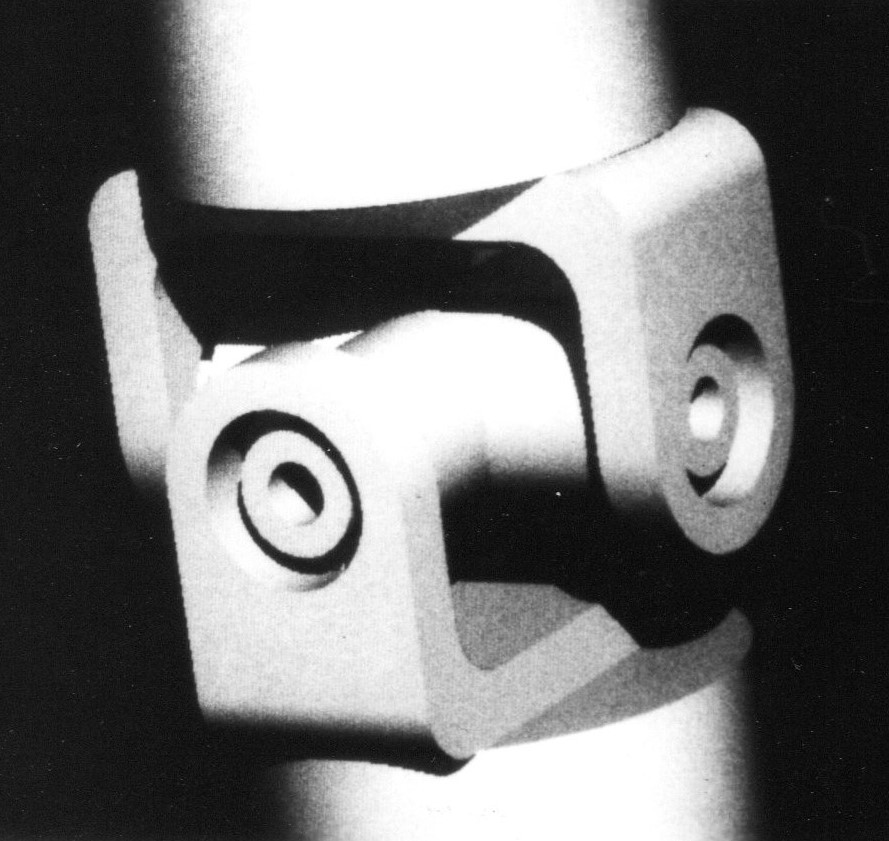|
Metaball
In computer graphics, metaballs are organic-looking ''n''-dimensional isosurfaces, characterised by their ability to meld together when in close proximity to create single, contiguous objects. In solid modelling, polygon meshes are commonly used. In certain instances, however, metaballs are superior. A metaball's "blobby" appearance makes them versatile tools, often used to model organic objects and also to create base meshes for sculpting. The technique for rendering metaballs was invented by Jim Blinn in the early 1980s to model atom interactions for Carl Sagan's 1980 TV series ''Cosmos''. It is also referred to colloquially as the "jelly effect" in the motion and UX design community, commonly appearing in UI elements such as navigations and buttons. Metaball behavior corresponds to mitosis in cell biology, where chromosomes generate identical copies of itself through cell division. Definition Each metaball is defined as a function in '' n'' dimensions (e.g., for three ... [...More Info...] [...Related Items...] OR: [Wikipedia] [Google] [Baidu] |
Marching Cubes
Marching cubes is a computer graphics algorithm, published in the 1987 SIGGRAPH proceedings by Lorensen and Cline, for extracting a polygonal mesh of an isosurface from a three-dimensional discrete scalar field (the elements of which are sometimes called voxels). The applications of this algorithm are mainly concerned with medical visualizations such as CT and MRI scan data images, and special effects or 3-D modelling with what is usually called metaballs or other metasurfaces. The marching cubes algorithm is meant to be used for 3-D; the 2-D version of this algorithm is called the marching squares algorithm. History The algorithm was developed by William E. Lorensen (1946-2019) and Harvey E. Cline as a result of their research for General Electric. At General Electric they worked on a way to efficiently visualize data from CT and MRI devices. The premise of the algorithm is to divide the input volume into a discrete set of cubes. By assuming linear reconstruction filt ... [...More Info...] [...Related Items...] OR: [Wikipedia] [Google] [Baidu] |
Isosurface
An isosurface is a three-dimensional analog of an isoline. It is a surface that represents points of a constant value (e.g. pressure, temperature, velocity, density) within a volume of space; in other words, it is a level set of a continuous function whose domain is 3-space. The term ''isoline'' is also sometimes used for domains of more than 3 dimensions. Applications Isosurfaces are normally displayed using computer graphics, and are used as data visualization methods in computational fluid dynamics (CFD), allowing engineers to study features of a fluid flow (gas or liquid) around objects, such as aircraft wings. An isosurface may represent an individual shock wave in supersonic flight, or several isosurfaces may be generated showing a sequence of pressure values in the air flowing around a wing. Isosurfaces tend to be a popular form of visualization for volume datasets since they can be rendered by a simple polygonal model, which can be drawn on the screen very q ... [...More Info...] [...Related Items...] OR: [Wikipedia] [Google] [Baidu] |
Computationally Expensive
In computer science, the analysis of algorithms is the process of finding the computational complexity of algorithms—the amount of time, storage, or other resources needed to execute them. Usually, this involves determining a function that relates the size of an algorithm's input to the number of steps it takes (its time complexity) or the number of storage locations it uses (its space complexity). An algorithm is said to be efficient when this function's values are small, or grow slowly compared to a growth in the size of the input. Different inputs of the same size may cause the algorithm to have different behavior, so best, worst and average case descriptions might all be of practical interest. When not otherwise specified, the function describing the performance of an algorithm is usually an upper bound, determined from the worst case inputs to the algorithm. The term "analysis of algorithms" was coined by Donald Knuth. Algorithm analysis is an important part of a broade ... [...More Info...] [...Related Items...] OR: [Wikipedia] [Google] [Baidu] |
Bézier Surface
Bézier surfaces are a species of mathematical spline used in computer graphics, computer-aided design, and finite element modeling. As with Bézier curves, a Bézier surface is defined by a set of control points. Similar to interpolation in many respects, a key difference is that the surface does not, in general, pass through the central control points; rather, it is "stretched" toward them as though each were an attractive force. They are visually intuitive, and for many applications, mathematically convenient. History Bézier surfaces were first described in 1962 by the French engineer Pierre Bézier who used them to design automobile bodies. Bézier surfaces can be of any degree, but bicubic Bézier surfaces generally provide enough degrees of freedom for most applications. Equation A given Bézier surface of degree (''n'', ''m'') is defined by a set of (''n'' + 1)(''m'' + 1) control points k''i'',''j'' where ''i'' = 0, ..., ''n'' and ''j'' ... [...More Info...] [...Related Items...] OR: [Wikipedia] [Google] [Baidu] |
NURBS
Non-uniform rational basis spline (NURBS) is a mathematical model using basis splines (B-splines) that is commonly used in computer graphics for representing curves and surfaces. It offers great flexibility and precision for handling both analytic (defined by common mathematical formulae) and modeled shapes. It is a type of curve modeling, as opposed to polygonal modeling or digital sculpting. NURBS curves are commonly used in computer-aided design (CAD), manufacturing (CAM), and engineering (CAE). They are part of numerous industry-wide standards, such as IGES, STEP, ACIS, and PHIGS. Tools for creating and editing NURBS surfaces are found in various 3D graphics and animation software packages. They can be efficiently handled by computer programs yet allow for easy human interaction. NURBS surfaces are functions of two parameters mapping to a surface in three-dimensional space. The shape of the surface is determined by control points. In a compact form, NURBS surfac ... [...More Info...] [...Related Items...] OR: [Wikipedia] [Google] [Baidu] |
XScreensaver
XScreenSaver is a free and open-source collection of 240+ screensavers for Unix, macOS, iOS and Android operating systems. It was created by Jamie Zawinski in 1992 and is still maintained by him, with new releases coming out several times a year. Platforms The free software and open-source Unix-like operating systems running the X Window System (such as Linux and FreeBSD) use XScreenSaver almost exclusively. On those systems, there are several packages: one for the screen-saving and locking framework, and two or more for the display modes, divided somewhat arbitrarily. On Macintosh systems, XScreenSaver works with the built-in macOS screen saver. On iOS systems, XScreenSaver is a stand-alone app that can run any of the hacks full-screen. On Android systems, the XScreenSaver display modes work either as normal screen savers (which Android sometimes refers to as "Daydreams") or as live wallpapers. There is no official version for Microsoft Windows, and the developer dis ... [...More Info...] [...Related Items...] OR: [Wikipedia] [Google] [Baidu] |
Demo Effect
Demo effect is computer-based real-time visual effects found in demos created by the demoscene. The main purpose of demo effects in demos is to show off the skills of the programmer. Because of this, demo coders have often attempted to create new effects whose technical basis cannot be easily figured out by fellow programmers. Sometimes, particularly in the case of severely limited platforms such as the Commodore 64, a demo effect may make the target machine do things that are supposedly beyond its capabilities. The ability to creatively overcome major technical limitations is greatly appreciated among demosceners. Modern demos are not as focused on effects as the demos of the 1980s and 1990s. Effects are rarely stand-alone content elements anymore, and their role in programmer showcase has diminished, particularly in PC demos. As for today, PC demosceners are more likely to demonstrate their programming skills with procedural content generation or 3D engine features than w ... [...More Info...] [...Related Items...] OR: [Wikipedia] [Google] [Baidu] |
Raycasting
Ray casting is the methodological basis for 3D CAD/CAM solid modeling and image rendering. It is essentially the same as ray tracing for computer graphics where virtual light rays are "cast" or "traced" on their path from the focal point of a camera through each pixel in the camera sensor to determine what is visible along the ray in the 3D scene. The term "Ray Casting" was introduced by Scott Roth while at the General Motors Research Labs from 1978–1980. His paper, "Ray Casting for Modeling Solids", describes modeled solid objects by combining primitive solids, such as blocks and cylinders, using the set operators union (+), intersection (&), and difference (-). The general idea of using these binary operators for solid modeling is largely due to Voelcker and Requicha's geometric modelling group at the University of Rochester. See Solid modeling for a broad overview of solid modeling methods. This figure on the right shows a U-Joint modeled from cylinders and blocks in a binary t ... [...More Info...] [...Related Items...] OR: [Wikipedia] [Google] [Baidu] |
Gaussian
Carl Friedrich Gauss (1777–1855) is the eponym of all of the topics listed below. There are over 100 topics all named after this German mathematician and scientist, all in the fields of mathematics, physics, and astronomy. The English eponymous adjective ''Gaussian'' is pronounced . Mathematics Algebra and linear algebra Geometry and differential geometry Number theory Cyclotomic fields *Gaussian period *Gaussian rational *Gauss sum, an exponential sum over Dirichlet characters **Elliptic Gauss sum, an analog of a Gauss sum ** Quadratic Gauss sum Analysis, numerical analysis, vector calculus and calculus of variations Complex analysis and convex analysis * Gauss–Lucas theorem *Gauss's continued fraction, an analytic continued fraction derived from the hypergeometric functions * Gauss's criterion – described oEncyclopedia of Mathematics* Gauss's hypergeometric theorem, an identity on hypergeometric series * Gauss plane Statistics * Gauss–K ... [...More Info...] [...Related Items...] OR: [Wikipedia] [Google] [Baidu] |
Square Root
In mathematics, a square root of a number is a number such that ; in other words, a number whose ''square'' (the result of multiplying the number by itself, or ⋅ ) is . For example, 4 and −4 are square roots of 16, because . Every nonnegative real number has a unique nonnegative square root, called the ''principal square root'', which is denoted by \sqrt, where the symbol \sqrt is called the '' radical sign'' or ''radix''. For example, to express the fact that the principal square root of 9 is 3, we write \sqrt = 3. The term (or number) whose square root is being considered is known as the ''radicand''. The radicand is the number or expression underneath the radical sign, in this case 9. For nonnegative , the principal square root can also be written in exponent notation, as . Every positive number has two square roots: \sqrt, which is positive, and -\sqrt, which is negative. The two roots can be written more concisely using the ± sign as \plusmn\sq ... [...More Info...] [...Related Items...] OR: [Wikipedia] [Google] [Baidu] |


